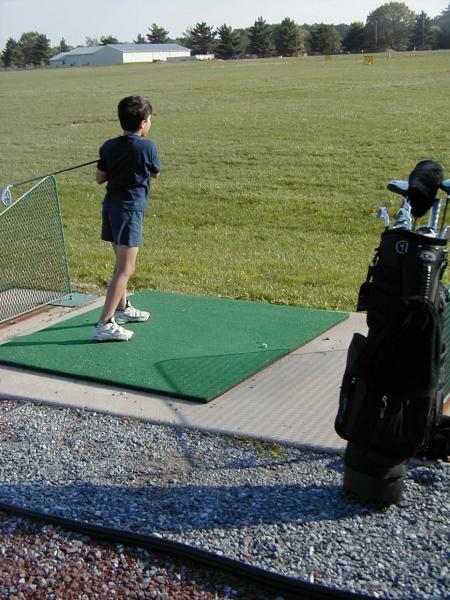
It is critically important that you and your child have realistic expectations about his or her development as an athlete and that you don't confuse your expectations and desires with those of your child. Parents who complain that their child has quit a sport too early may be doing so because he isn't doing what they want or expect him to do.
As the American Medical Society for Sports Medicine stated in a recent position statement on overuse injuries and burnout, "coaches and parents often lack knowledge about normal development and signs of readiness for certain tasks, both physically and psychologically," which can result, says the AMSSM, in "unrealistic expectations that cause children and adolescents to feel as if they are not making progress in their sport, especially related to their chronological peers." The result can be a loss of self-esteem and withdrawal from the sport.
All Work and No Play
Fun can go out of sports for a youth athlete in a hurry when it stops being what she does just for fun and becomes something she does for an external reason: to get a scholarship, to win a game, to impress a scout, to please a parent. When such reasons for playing take over, the game becomes a chore and burnout becomes more likely.
Control
Whether pressure to participate for external reasons leads to burnout depends on how much control the athlete feels he has over the situation: If he feels in control, if athletic participation is part of his self-development, then sports can be healthy part of the growing up process. If he feels controlled or feels that he is not making the decisions or developing as an individual, burnout is more likely.
Phases of Athletic Development
Côté's Developmental Model of Sports Participation (DMSP), developed from studies of elite athletes in Canada and Australia in a number of sports, including basketball, hockey and tennis, identifies three distinct phases of athletic development in children, which need to be respected:
- The emphasis in the first phase (from ages six through thirteen) should be on having fun, sampling lots of different sports or activities to find the ones a child likes and developing fundamental skills. It is a time for you to encourage your child's participation and not a time to set expectations or goals, other than having fun and doing one's best and learning life lessons thorugh sports. Trying to accelerate the process of developing your child into an elite athlete by skipping this initial phase usually backfires. If your child does not develop a love of the sport and a desire to improve, experts like Daniel Gould, director of the Michigan States Institute for the Study of Youth Sports, warn, "it is highly unlikely he or she will be able to sustain long-term involvement (although your child may stay involved for a number of years to please [you])."
- In the second phase (from ages thirteen to fifteen) your child begins to commit to a sport (or sports) and to focus in a long-term and systematic way, with the help of an experienced coach, on mastering skills and techniques.
- In the third phase-beginning at around age fifteen-a child continues to work with a coach to turn technical skills learned in practice into optimal performance in competition, and recognizes the significance of the sport in his or her life.
Your Passion Doesn't Equal His
You can encourage, needle, cajole, or demand that your child practice more, but no matter how passionate you may be and how sure you may be that extra practice will pay off, your passion is no substitute for the passion he needs in order to want to put in the extra practice time. You need to help your child value his own developmental process and improvement over time. The focus should be on your child's overall happiness, a balance of fun and development, and the general developmental benefits of involvement in sports. Winning and success should not be the predominant objectives of participation, regardless of which phase your child is in.
Avoid the Mind-Set that More is Better
Additional practice may improve your child's performance, hone her skills, and help her become more confident; but it is not going to turn her into a star athlete or compensate for a lack of natural athletic talent. There is a fine line between gentle encouragement, with your child feeling that the final decision about whether to practice more is hers, and pushing so hard to persuade your child to practice that she doesn't feel the decision was hers to make. If she ends up giving into your demands, the chances that she will ultimately quit are much higher, as are the chances the extra practice will result in overuse injuries.
Physical Limits
Parents often forget that children do not have an unlimited capacity for physical exercise. They get tired, just like you, and may not be ready or physically able to handle extra practicing and conditioning.
Comparison Trap
There are always going to be kids ahead of or behind your child. It is not how she is doing against friends, a sibling, an older player, or a star athlete that is important. She isn't competing against anyone but herself. The goal is to develop her individual potential to the fullest, not to beat some other young athlete.
Brooke de Lench is the Executive Director of the non-profit MomsTEAM Institute, Founder and Publisher of MomsTEAM.com, and Producer/Director/Creator of the PBS concussion documentary, "The Smartest Team: Making High School Football Safer."
Sources:
Côté J, Lidor R, Hackfort D. ISSP position stand: To sample or specialize? Seven postulates about youth sport activities that lead to continued participation and elite performance. Int'l J Sport & Exer Psychol. 2009;9:7-17.
DiFiori JP, Benjamin HJ, Brenner J, Gregory A, Jayanthi N, Landry GL, Luke A. Overuse Injuries and Burnout in Youth Sports: A Position Statement from the American Medical Society for Sports Medicine. Clin J Sports Med. 2014;24(1):3-20.









